
St. John's Episcopal Church is a historic Episcopal church located on the village green in the village of Highgate Falls in Highgate, Vermont, in the United States. Built 1829–30, it is prominent local example of a Federal style church with Gothic Revival features. On September 3, 1976, it was listed on the National Register of Historic Places.

The Enosburg Congregational Memorial Church is a historic church on Boston Post Road in Enosburg, Vermont. Built in 1820 and expanded fifty years later, it is a prominent example of ecclesiastical Italianate architecture. It was listed on the National Register of Historic Places in 2001.

The Memorial United Methodist Church is a historic church in the village of Swanton, Vermont. Built in 1895, it is an architecturally distinctive example of Queen Anne architecture executed in brick. It was listed on the National Register of Historic Places in 2001.

WEVT-LP is a radio station licensed to Enosburg Falls, Vermont, United States. The station is owned by Spavin Cure Historical Group. WEVT-LP is one of the oldest Low Power FM Stations in Vermont, with broadcasting starting on November 15, 2004.
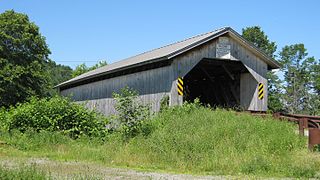
The Hopkins Covered Bridge is a wooden covered bridge that crosses the Trout River in Enosburg, Vermont on Hopkins Bridge Road. Built in 1875 by brothers Sheldon & Savannah Jewett, it is one of a cluster of area covered bridges all attributed to the same builders. It was listed on the National Register of Historic Places in 1974.

The G.O. Sanders House is a historic house at 10 Derry Street in the center of Hudson, New Hampshire. Built in 1873-75 by George Sanders, this 2+1⁄2-story wood-frame house is a well-preserved example of French Second Empire style. It was listed on the National Register of Historic Places in 1986.

The Conant-Sawyer House is a historic summer house at 14 Kendall Road in York Beach, Maine. Built in 1877 and enlarged in 1896, it is a well-preserved example of a late 19th-century upper middle-class summer house. Its notable owners include Sumner Wallace, a shoe manufacturer from Rochester, New Hampshire, and Charles Henry Sawyer, Governor of New Hampshire. The house was listed on the National Register of Historic Places in 1992.

North Bennington station is a historic railroad station at Depot Street and Buckley Road in North Bennington, Vermont. Built in 1880 as a passenger station, this Second Empire brick building is a surviving reminder of North Bennington's former importance as a major railroad hub in southwestern Vermont. It was listed on the National Register of Historic Places in 1973 as North Bennington Depot.

The Ludlow Graded School is a historic former school building at 10 High Street in the village of Ludlow, Vermont. Built in 1871–72, the school was for many years the primary school feeding the adjacent Black River Academy. The building now serves as a local senior services center. It was listed on the National Register of Historic Places in 1979.
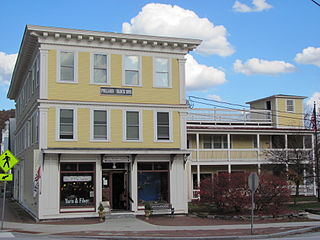
The Pollard Block is a historic commercial building at 7 Depot Street in Cavendish, Vermont. Built in 1895, it is a fine local example of commercial Italianate architecture, and was home to the village general store for 70 years. It was listed on the National Register of Historic Places in 2008.

College Hall is the central building of the campus of the Vermont College of Fine Arts in Montpelier, U.S. state of Vermont. Located prominently on Ridge Street atop Seminary Hill, this 1872 Second Empire building has been a major visual and architectural landmark in the city since its construction. It was listed on the National Register of Historic Places for its architectural significance in 1975.
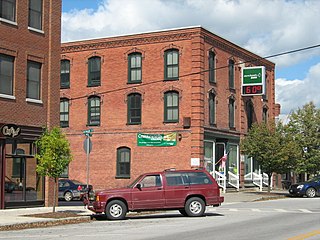
The Billado Block is a historic commercial building at 371 Main Street in the Enosburg Falls village of Enosburgh, Vermont. Erected about 1885, it is the town's oldest surviving brick commercial building, built during a period of growth occasioned by the arrival of the railroad in the village. It was listed on the National Register of Historic Places in 2007.
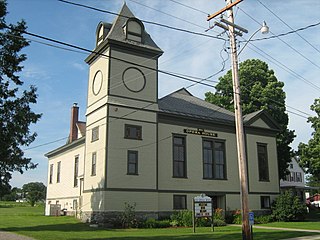
The Enosburg Opera House is a historic performance venue and meeting space at 123 Depot Street in Enosburg Falls, Vermont. Built in 1892 by the B.J. Kendall Company, a prominent local employer, it has been used since then as a regionally prominent performance venue. It also serves as the site of Enosburg's town meetings. It was listed on the National Register of Historic Places in 1978.
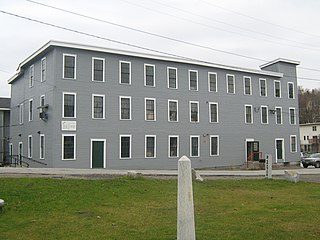
The National Clothespin Factory is a historic industrial building at One Granite Street in Montpelier, Vermont. Built in 1918, it is a significant local example of an early 20th-century wood-frame factory, and was home to the nation's last manufacturer of wooden clothespins. Now adapted for other uses, the building was listed on the National Register of Historic Places in 2005.

The Richwood Estate is a historic house on United States Route 7 in southern Swanton, Vermont. It was built in 1871 for C.W. Rich, owner of a local lime processing company, and is a distinctive example of Second Empire architecture using native materials. It was listed on the National Register of Historic Places in 1988.

The Quincy Hotel is a historic commercial building at 57 Depot Street in the Enosburg Falls village of Enosburgh, Vermont. Built about 1876 in the Second Empire style, it was restyled after a fire in the early 20th century to its present Colonial Revival appearance to a design by Vermont architect Lewis Newton. It was listed on the National Register of Historic Places in 2019 for its architectural significance.

The Fire District No. 2 Firehouse, also known locally as the Yosemite Engine House, is a historic fire station at 716 Depot Street in Chester, Vermont, United States. Built in 1879, it is architecturally distinctive in the state as the only period fire station with two towers, which also distinctively exhibit Second Empire styling. Now owned by the town, it was listed on the National Register of Historic Places in 2020.

The Moses P. Perley House is a historic house at 527 Main Street in Enosburg Falls, Vermont, United States. Built in 1903, it is a locally prominent example of the Shingle and Colonial Revival styles of architecture, designed by Burlington architect Walter R. B. Willcox for a local businessman. The house was listed on the National Register of Historic Places in 2020. It is now a bed and breakfast inn.
The E.J. Bullock Block is a historic commercial building at 7012 Main Street in Readsboro, Vermont. Built in 1891, it is a prominent local example of Second Empire architecture, with a long history of commercial, social, and civic uses. The building was listed on the National Register of Historic Places in 2021.
The Perley Block is a historic commercial building at 366 Main Street in the Enosburg Falls village of Enosburgh, Vermont. Built in 1908 in the Renaissance Revival style, its ground-floor facade was given a Modernist update c. 1960. It was listed on the National Register of Historic Places in 2021 for its architecture.





















